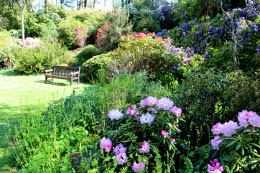Evergreen shrubs are mostly planted for creating privacy hedges and as screens. Let's take a look at the different types of evergreen shrubs, and the basic tips to identify them.

Evergreen shrubs are plants that retain their foliage and remain green throughout the year. They differ from the evergreen trees by their limited height (of about 5 meters) and multiple number of stems. Evergreen shrubs are used in gardening for several purposes; flowering shrubs are used as ornamental plants, whereas creeping shrubs are used as groundcover plants.
Common Types of Evergreen Shrubs
There are many types of evergreen shrubs; some of them produce flowers, whereas others are non-flowering species. They may also differ in terms of their leaf size and shape; for example, you will come across both broad-leaf and narrow-leaf evergreen shrubs. Here are some of the popular evergreen shrubs that are commonly used in landscaping.
- Junipers - Junipers are popular shrubs that are used either for creating privacy hedges or as borders for property. There are many varieties of junipers and their height range from one foot to 15 feet. If you feel sharp spines while touching the shrub canopy, then the plant is probably a juniper.
- Yews - Yews are shrubs with soft needle-shape foliage. They serve best as privacy hedges and screens. The size and growth form of the yew shrubs depend on the species type. Since they are highly adaptive and shade tolerant, they are also used in indoor gardening. While taking care of the plants, make sure the soil is not waterlogged.
- Arborvitae - Arborvitae are used as screens or hedges. The foliage is somewhat scalelike and it may exhibit different colors as per the species. The growth pattern is either pyramidal or flattened. Both dwarf and tall varieties (40 - 50 feet high) of arborvitae are available.
Well! These are some of the common evergreen shrubs. There are other dwarf varieties of evergreen trees which can be trained as shrubs. Examples of the same include pine, fir, and spruce. Various evergreen shrubs have medicinal properties and are used in herbal medicine. For example, rosemary is a medicinal shrub planted in herb gardens. Rosemary leaves are used for strengthening the heart and improving memory.
Tips for Identifying Evergreen Shrubs
Evergreen shrubs show certain characteristics. It is a fact that all these shrubs lose some of their leaves, every year. Here are some of the tips that can be used for identifying evergreen shrubs.
- Most of them grow better in sunny areas. If you are growing flowering evergreen shrubs, then the plants should be exposed to maximum light in the blooming season.
- Shrubs with broad leaves thrive well in conditions, where they are protected from harsh winds, winter sun, and cold. They require consistent soil moisture for optimum growth.
- While planting the shrubs, make sure you leave enough space between two saplings. They expand about one foot per year. It is to be noted that evergreen shrubs are wider at the base than at the top.
- Evergreen shrubs increase in size every year, if they are grown in favorable plant growth conditions. The size of the plant can be maintained by pruning. In case of the flowering shrubs, pruning should be done after the blooming period is over.
For landscaping purpose, you can choose from a wide variety of evergreen shrubs, depending upon the soil, area availability, and landscape plan. If you have a limited planting area, you can use those shrubs that spread minimally, for e.g. upright junipers and emerald-green arborvitae. As for creating butterfly gardens, flowering evergreen shrubs that have rich fragrances can be used. Since these shrubs are tolerant to pruning and can be shaped and designed, they are also used for creating bonsai and indoor gardening.






 Evergreen shrubs are plants that retain their foliage and remain green throughout the year. They differ from the evergreen trees by their limited height (of about 5 meters) and multiple number of stems. Evergreen shrubs are used in gardening for several purposes; flowering shrubs are used as ornamental plants, whereas creeping shrubs are used as groundcover plants.
Evergreen shrubs are plants that retain their foliage and remain green throughout the year. They differ from the evergreen trees by their limited height (of about 5 meters) and multiple number of stems. Evergreen shrubs are used in gardening for several purposes; flowering shrubs are used as ornamental plants, whereas creeping shrubs are used as groundcover plants.